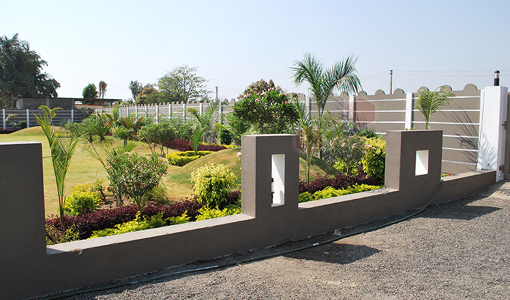Compound Wall

About Compound Wall
A compound wall serves to demarcate the site, protect one's property, ensure privacy and enhance aesthetic appeal. The most important reason for having a fence is security. Not only does a fence prevent encroachers from moving into your property but also effectively restricts entry into your space. Most city houses are independent units and therefore invariably have their compound walls.The most commonly used fencing option is the compound wall made of concrete. Other options include timber, picket fences that are also wood-based, wrought iron fences and natural hedges.
Retaining walls are used to retain earth( or any other material) in a vertical position at locations where an abrupt change in ground level occurs. The reataining wall therefore, prevents the retained earth from assuming it's natural angle of repose. This causes the retained earth to exert a lateral pressure on the wall, thereby tending to bend, overturn and slide the retained wall structure.Compound wall provides aesthetic appearance, privacy and security to your property. It prevents movements of unwanted objects in your property. It separates your property from neighbors property and gives a perfect demarcation to your property.
The Compound wall acts as the first layer of protection from unwanted entrants. It protects the site and house from animals, thieves, etc and serves to demarcate the boundary of the property. The compound wall gives a feeling of safety and security to the property and the residents and it is considered essential in Vastu Shastra. If it is not possible to construct a compound wall, the site /house should be fenced off with fencing or paling.the Compound wall is to protect the site and the material stored in the Storage shed, from the outside environment, etc. However, if there are buildings all around the site, the Compound wall can be done after the construction.
The purposes of the walls in buildings are to support roofs, floors and ceilings; to enclose a space as part of the building envelope along with a roof to give buildings form; and to provide shelter and security. In addition, the wall may house various types of utilities such as electrical wiring or plumbing. Wall construction falls into two basic categories: framed walls or mass-walls. In framed walls the load is transferred to the foundation through posts, columns or studs. Framed walls most often have three or more separate components: the structural elements (such as 2 by 4 studs in a house wall), insulation, and finish elements or surfaces (such as drywall or panelling).

